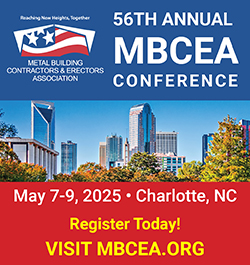UP TO THE MINUTE
Navigating the challenges of succession planning for roofing contractors

By Cotney Consulting Group.
With the future in mind, succession planning can be a strategic process for roofing contractors.
In small and family owned roofing businesses, versatility is not just a virtue; it's a necessity. Business owners don multiple hats, balancing roles as accountants, lawyers, consultants, marketers and HR specialists. While this adaptability is the cornerstone of their enterprises, it often poses a daunting challenge when contemplating retirement or business exits. The complexities of succession planning can seem overwhelming, especially without access to specialized expertise. This article aims to bridge the knowledge gap by delving into essential aspects crucial for a smooth transition, offering insights ranging from life and career planning to the nuances of talent management and the intricacies of financial, legal and psychological considerations.
Deciding what to do: Life and career planning for small business owners and family leaders
The journey of succession planning starts with self-reflection. Roofing contractors must ponder their life goals, personal aspirations and the legacy they wish to leave behind. This introspection acts as a compass, guiding them to align their professional choices with their ambitions.
Considering your choices
Succession planning is not a one-size-fits-all endeavor. Roofing contractors must weigh their options meticulously. Will the next leader emerge from within the family, or should external talent be considered? Is a merger or acquisition a viable path? These decisions require careful evaluation to align the business with the best possible future trajectory.
Planning for succession in small and family business
Crafting a robust succession plan demands strategic foresight. Identifying potential successors is just the beginning; nurturing their skills and acumen is equally vital. This involves a blend of mentorship, training programs and hands-on experience to prepare them for leadership responsibilities.
Special issues in small and family business succession planning
Family dynamics and politics add layers of complexity to succession planning in roofing businesses. Striking a balance between familial relationships and business interests is paramount. Addressing conflicts, defining roles and fostering transparent communication channels are essential steps in mitigating potential challenges.
Navigating the legal, financial and psychological terrain
Succession planning transcends mere logistics; it delves into law, finance and psychology. Roofing contractors must grapple with emotional aspects, such as relinquishing control and embracing change. Simultaneously, understanding legal intricacies, tax implications and financial nuances is indispensable. Seeking expert advice from legal and financial professionals can provide invaluable guidance in navigating these complexities.
Effective talent management and transitioning the business
Central to a successful succession plan is talent management. Identifying, grooming and retaining skilled individuals ensures a seamless transition. Moreover, executing the plan necessitates meticulous coordination, from transferring ownership to ensuring a smooth handover of responsibilities.
The art of executing the plan
While crafting a succession plan is a monumental task, the true challenge lies in its execution. Every plan is prone to unforeseen difficulties and hurdles regardless of how meticulously designed. With its unique set of dynamics, the roofing industry necessitates a flexible yet firm approach in this final phase of succession planning.
Recruiting a successor: Diverse options, one goal
Choosing a suitable successor is pivotal. Whether selecting from the family's next generation, headhunting external talent, or considering mergers and acquisitions, roofing contractors need a clear set of criteria. While family members bring a deep understanding of business values, external candidates might introduce fresh perspectives. Mergers or acquisitions, on the other hand, can offer scalability and market expansion. Each option has merits, but the end goal remains: ensuring the business's growth and sustainability.
The role of family dynamics in decision-making
Family owned roofing businesses face an additional layer of complexity: managing family dynamics. Sentiments, aspirations and sometimes egos play a role in decision-making. It's essential to differentiate between what's best for the family and what's best for the business. Open dialogues, facilitated discussions and even family business retreats can be invaluable in these scenarios.
Addressing questions and ensuring clarity
Naturally, a plethora of questions arise during the succession planning process. Business owners may grapple with psychological concerns about their post-retirement identity, the emotional toll of letting go or how to handle potential conflicts. Legally, transferring ownership, contracts and proprietary rights can pose challenges. Financially, understanding valuation tax implications and ensuring financial security for the retiring generation is paramount. Regarding talent management, retaining key employees, upskilling the team and ensuring continuity in customer relationships is vital. Addressing these questions with the help of experts can provide clarity and confidence to both the incumbent and successor.
Ensuring a smooth transition
Finally, as you pass the baton, ensuring a smooth transition is crucial, which involves administrative tasks like transferring licenses and notifying stakeholders and the more intangible aspects. Mentorship programs, where the predecessor guides the successor through the initial phase, can be instrumental. Celebrating the transition, perhaps through a formal event or announcement, can foster goodwill and set the tone for the business's next chapter.
In the ever-changing world of roofing, where challenges are as diverse as solutions, ensuring the business's legacy through effective succession planning is an art and a science. It requires vision, persistence and a deep commitment to the future. But with the proper guidance and a comprehensive approach, roofing contractors can ensure that their hard-earned legacy thrives for generations to come.
Learn more about Cotney Consulting Group in their Coffee Shop Directory or visit www.cotneyconsulting.com.



















Comments
Leave a Reply
Have an account? Login to leave a comment!
Sign In